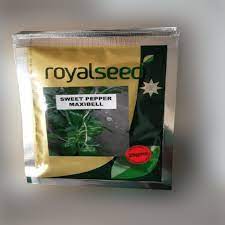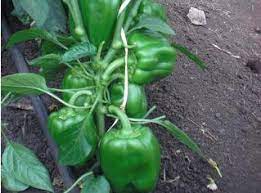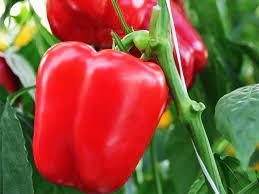No products in the cart.
Return To Shop
0
₦0.00
0
Shopping cart (0)
Subtotal: ₦0.00
Spend ₦500.00 to get free shipping Congratulations! You've got free shipping.
Log in / Sign up
Login Register
Marvel F1 Sweet Pepper Hybrid ...
₦10,499.00


Mekong F1 sweet Pepper Eastwes...
₦8,000.00
Maxibell Sweet Pepper Seeds
₦31,000.00
Maxibell Sweet Pepper Seeds
Maxibell Sweet Pepper Seeds is a refined open-pollinated sweet pepper from Royal Seed Company. It has a long shelf life and is excellent for production in greenhouses and open fields. sweet pepper seeds is a typical blocky, glossy green fruit with a strong fruiting capacity.
Features That Elevate Your Gardening Experience
-
Exceptional Yield: Witness an impressive production of 8 tonnes of peppers per acre, ensuring a bountiful supply for fresh consumption, preservation, or market sales.
-
Long Shelf Life: Enjoy extended freshness with peppers that maintain their vibrant color and crispness, extending their culinary versatility for weeks to come.
-
Greenhouse and Open-Field Adaptability: Unleash the potential of these peppers regardless of your growing environment. Maxibell Sweet Pepper Seeds thrive in both greenhouse settings and open fields, catering to diverse cultivation preferences.
35 people are viewing this product right now
Please, activate Compare option to use this widget.
Estimated delivery:4 days
Share:
Maxibell Sweet Pepper Seeds
Embark on a culinary adventure with Maxibell Sweet Pepper Seeds, the gateway to an explosion of flavors and vibrant hues in your garden or greenhouse. Renowned for their exceptional yield and adaptability, these open-pollinated gems effortlessly thrive in both controlled environments and open fields.
Royal Seeds Company produces the Maxibell sweet pepper. Maxibell is a typical blocky, glossy green fruit with a high rate of fruiting.
Maxibell Sweet Pepper Maturity Characteristics
75 days after the fruit is transplanted, it weighs 120–150 grams.
Potential yield of 8 tonnes per acre
Ideal for both greenhouses and open fields, long shelf life
fruits with deep green coloring
typical blocky, shiny, green fruits
Tolerances / Resistances
TM1 (Tobacco Mosaic Virus)
Diaper Mildew
Violet Spot Tolerance
Tolerance to anthocyanins
Health Benefits
Reduce the risk of cataracts and macular degeneration
Defend against some chronic illnesses
Delay memory loss due to aging
lessen the chance of anemia
Promotes heart health
reduces migraines
alleviates joint pain
increase in metabolism
combats bacterial, viral, and fungal infections
stops foul breath
Growing Sweet Pepper
Bell peppers are easy to grow, but temperature is a key consideration.
Begin pepper plants indoors. 7–10 weeks before the day you plan to plant seedlings in the garden.
In a seedlings tray, sow three to four seeds per pot or flat.
Plant seeds 1/4 to 1/2 inch deep.
Warmer conditions are ideal for germination.
Till the seedlings appear, keep the seed-starting mixture gently damp.
When the strongest seedling reaches a height of around 5 cm, clip away the weaker sprouts.
After germination, seedlings started inside should be kept under a grow lamp or in a sunny window.
Water is readily available to prevent the seed from starting to mingle.
Once seedlings are 5 to 10 cm tall, move them to a larger container, making sure they have enough room for root development. This procedure is known as “potting up.” As seedlings outgrow their pots, keep repotting them until they are moved into the garden or a very big container.
Plant peppers 45 to 61 cm apart. rows 61 to 91 cm apart
Young peppers should be 10-15 cm tall when transplanted.
Before transplanting, plants that were started indoors should become accustomed to the outdoor climate. Before transferring plants to the farm, place them outside for a few hours each day.
Peppers do best in full sun. Each day, peppers need 8 hours of direct sunlight.
Plant peppers in organically rich soil. Prior to planting, add compost or commercial organic planting mix to beds.
The soil should retain moisture while still having good drainage. The ideal soil is slightly sandy or loamy.
Before transplanting peppers, pre-warm the soil by covering the planting area with mulch film for two weeks. Solar heat will be transmitted to the soil through the plastic.
Plant transplants at the same depth they were growing in the container in the garden. Planting deeper could cause the stem to decay.
When your peppers are ready for harvest, you can easily tell. Once the peppers are 7.6 to 10 cm long and the fruit is firm and green, you may start picking them.
Feel free to fertilize the plants after you’ve harvested the first crop of peppers to provide them with the energy they need to produce another crop.
Frequently Asked Questions (FAQs) About Maxibell Sweet Pepper Seeds
What are Maxibell Sweet Pepper Seeds?
Maxibell Sweet Pepper Seeds are an open-pollinated variety known for their exceptional yield, adaptability, and vibrant green blocky fruits. They thrive in both greenhouses and open fields.
What are the benefits of growing Maxibell Sweet Peppers?
- High Yield: Maxibell peppers offer a potential yield of 8 tonnes per acre.
- Adaptability: They thrive in both greenhouses and open fields.
- Long Shelf Life: Maxibell peppers boast a long shelf life, keeping their freshness for extended periods.
- Disease Resistance: They have some resistance to common diseases like Tobacco Mosaic Virus, Downy Mildew, and others.
- Health Benefits: Sweet peppers, in general, offer various health benefits, including reducing the risk of chronic diseases, promoting heart health, and containing essential vitamins.
How long does it take for Maxibell Sweet Peppers to mature?
Maxibell Sweet Peppers mature approximately 75 days after transplanting.
How do I grow Maxibell Sweet Peppers?
- Start peppers indoors: Begin seeds 7-10 weeks before transplanting outdoors.
- Sow seeds: Use a seedling tray and plant 3-4 seeds per pot.
- Maintain moisture: Keep the seed-starting mix damp until germination.
- Thin seedlings: After germination, remove weaker seedlings.
- Provide sunlight: Use a grow lamp or sunny window for indoor seedlings.
- Repotting: As seedlings grow, repot them to larger containers for proper root development.
- Transplanting: Transplant seedlings outdoors once they reach 5-10 cm in height.
- Spacing: Plant peppers 45-61 cm apart in rows 61-91 cm apart.
- Sunlight: Peppers require full sun (8 hours daily).
- Soil: Plant peppers in well-draining, organically rich soil. Add compost or organic planting mix before planting.
- Watering: Water regularly to maintain soil moisture.
- Harvesting: Peppers are ready to harvest when they reach 7.6-10 cm in length and have firm, green flesh.
Only logged in customers who have purchased this product may leave a review.



Reviews
There are no reviews yet.